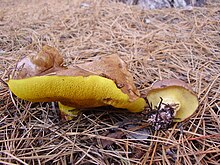
Back Suillus collinitus CEB Ringloser Butterpilz German Suillus collinitus Basque Suillus collinitus French אורנית נימים HE Rózsástövű fenyőtinóru Hungarian Suillus collinitus Italian Valse melkboleet Dutch Maślak rdzawobrązowy Polish Suillus collinitus PMS
| Suillus collinitus | |
|---|---|

| |
| Scientific classification | |
| Domain: | Eukaryota |
| Kingdom: | Fungi |
| Division: | Basidiomycota |
| Class: | Agaricomycetes |
| Order: | Boletales |
| Family: | Suillaceae |
| Genus: | Suillus |
| Species: | S. collinitus
|
| Binomial name | |
| Suillus collinitus | |
| Varieties | |
|
S. collinitus var. aureus Huijsman | |
| Synonyms | |
| |
| Suillus collinitus | |
|---|---|
| Pores on hymenium | |
| Cap is convex or flat | |
| Hymenium is decurrent | |
| Stipe is bare | |
| Spore print is brown | |
| Ecology is mycorrhizal | |
| Edibility is edible | |
Suillus collinitus is a pored mushroom of the genus Suillus in the family Suillaceae. It is an edible mushroom found in European pine forests. The mushroom has a reddish to chestnut-brown cap that reaches up to 11 cm (4.3 in) in diameter, and a yellow stem measuring up to 7 cm (2.8 in) tall by 1 to 2 cm (0.4 to 0.8 in) thick. On the underside of the cap are small angular pores, initially bright yellow before turning greenish-brown with age. A characteristic feature that helps to distinguish it from similar Suillus species, such as S. granulatus, is the pinkish mycelia at the base of the stem.
Molecular analysis has shown the species to be related to other typical Mediterranean Suillus species such as S. bellinii, S. luteus, and S. mediterraneensis. S. collinitus is a mycorrhizal species, and forms associations with several species of pine, most notably the Aleppo pine. This tree species is commonly used in reforestation schemes and soil conservation against erosion in the Mediterranean region, and S. collinitus is often used as a beneficial inoculant to help the young trees better survive in typically harsh soil conditions.
© MMXXIII Rich X Search. We shall prevail. All rights reserved. Rich X Search